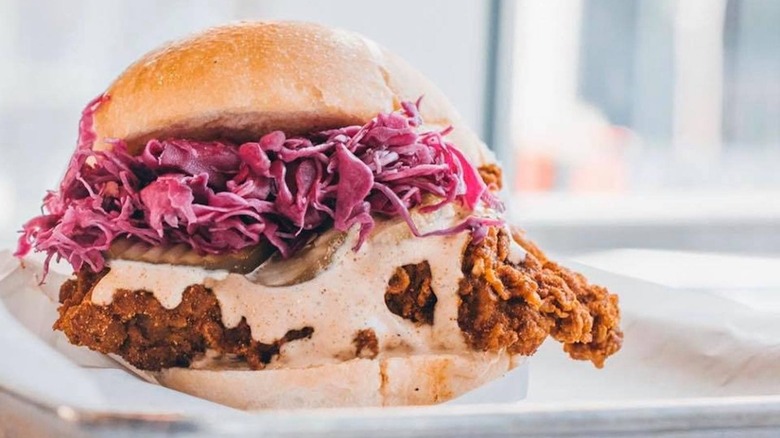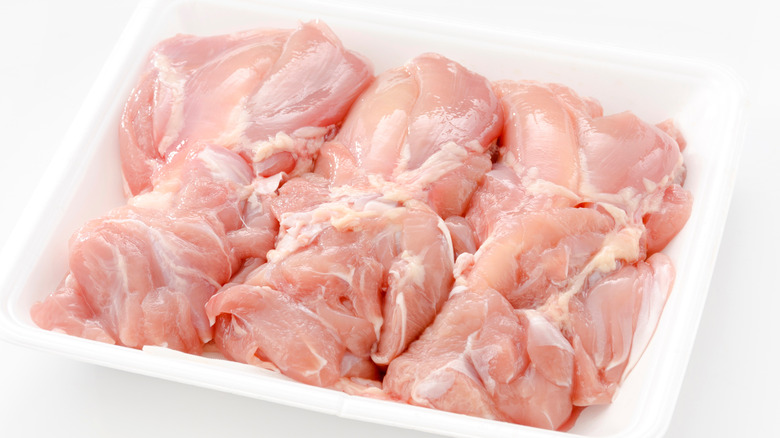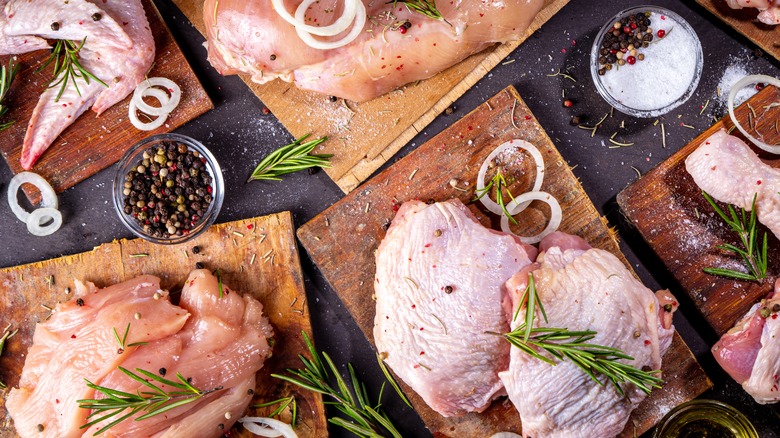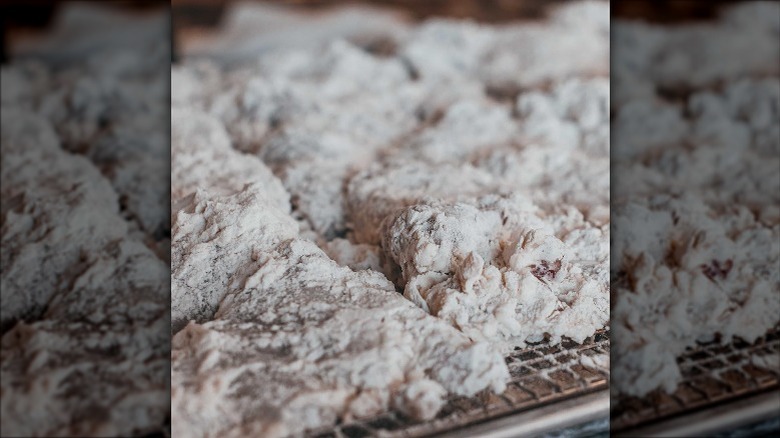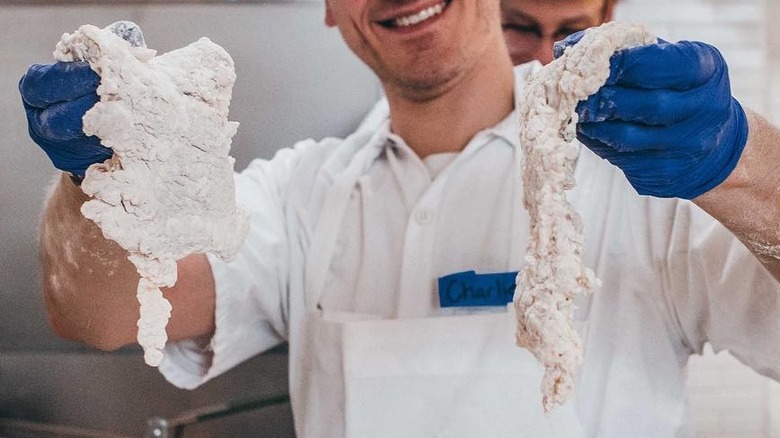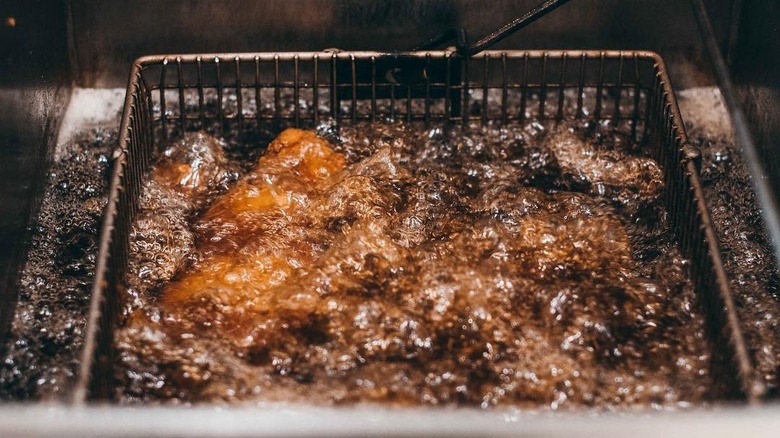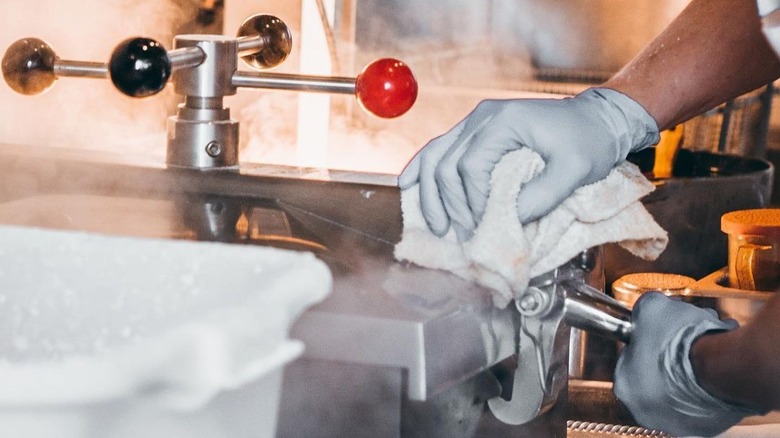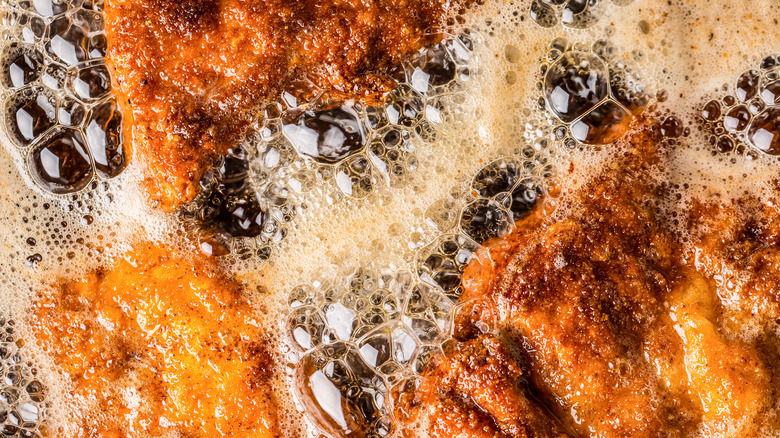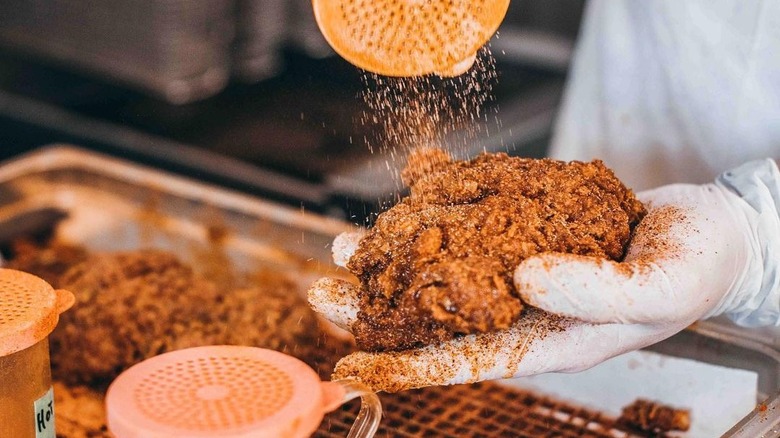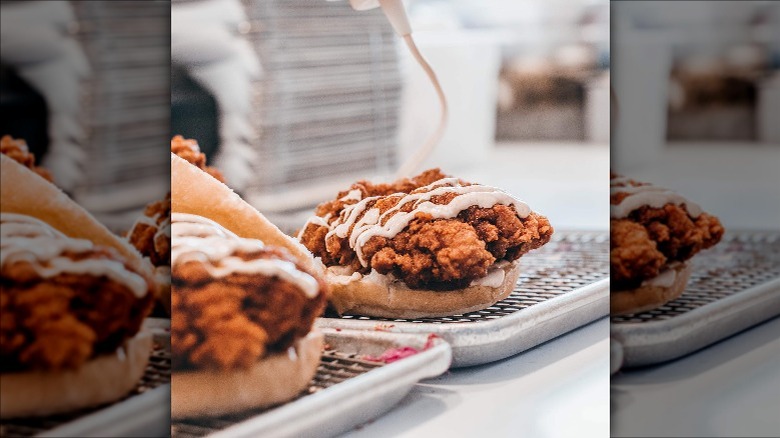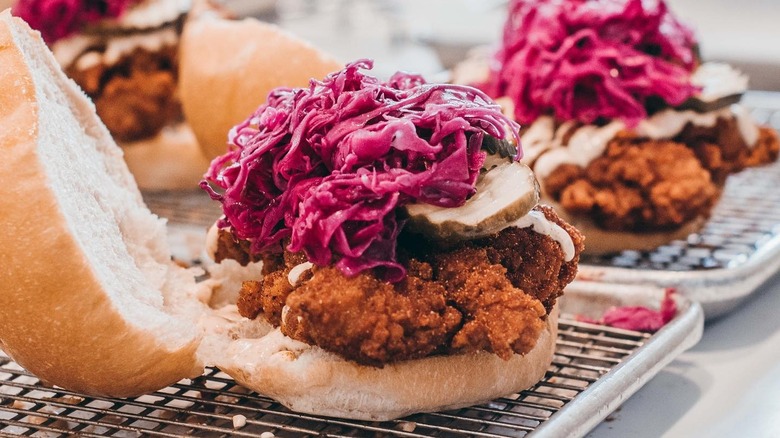10 Essential Tips For Making Nashville Hot Chicken, According To Viet Pham - Exclusive
Fried chicken is a tried and true southern tradition, but in recent years, it's been upstaged in the world of food trends as more and more people are discovering the tasty yet tongue-torturing experience that is Nashville hot chicken. Now, the legendary dish has made its way outside of Nashville to restaurants across the country, and even into our kitchens as more and more home chefs want to see if they can take the heat.
However, making hot chicken isn't as simple as throwing some meat in the fryer and tossing it in the hottest chili powder you can find. You want it to hurt so good, not taste so bad, and that takes some finesse. To help hone your skills, Tasting Table spoke to bonafide expert in all things Nashville hot chicken, Chef Viet Pham. You might have seen him slaying the competition with his hot chicken on Food Network cooking competitions — chicken that beat Bobby Flay, we might add — and more recently he's been elevating the Salt Lake City dining scene with his fast-casual hot chicken restaurant, Pretty Bird Chicken.
Pham shared some of his essential tips for making Nashville hot chicken in its finest and tastiest form from start to finish. From the piece of chicken you choose to the all-important dredging, the art of adding spice, and the final touches you need to complete the dish, follow his expert guidance and your taste buds will surely be crying out from the best kind of pain.
1. Opt for dark meat
When you bite into a fried chicken sandwich at a restaurant or fast-casual joint, there's a good chance you're going to be chowing down on chicken breast. Think about how many places advertise 100% all-white meat chicken. Chef Viet Pham also confirms that when he got into the Nashville hot chicken game, chicken breasts were universal. "[Roughly] 99% of the places selling fried chicken sandwiches were all using boneless, skinless chicken breasts," he says.
However, if you want to make hot chicken that is a step above every other guy, Pham says to go for cuts of dark meat chicken instead, like boneless skinless chicken thighs. Dark meat has a higher fat content than white meat, and it's no secret that more fat means more flavor. Once you dredge and fry those pieces up, you're going to be left with a much tastier result. "At the end of the day, it's just more succulent — it's juicier," says Pham.
2. Start off with a dry brine
The key to great fried chicken is moisture and flavor — and brining helps achieve both things before you ever even start cooking your meat. Chef Pham opts for a dry brine over a wet brine, which imparts a lot more intense flavor directly onto the surface of your chicken. At Pretty Bird, Nashville hot chicken gets coated in sugar, salt, and white pepper. "Then we add a tiny bit of buttermilk, which binds it all together ... so that it coats all the chicken evenly," Pham says.
The only other ingredient required for this part of the process is patience. Stick your chicken in the fridge and let the brine do its work for roughly 18 hours, or overnight, giving plenty of time for the protein to tenderize and the muscle tissue to saturate, allowing it to hold on to moisture during the cooking process. It takes some time, but once you bite into a juicy and tasty piece of fried chicken, you'll be glad you didn't skip this step.
3. Your dredge mixture matters
When you're making fried chicken, spicy or otherwise, one of the most important elements that will affect the final texture is the dry dredge mixture you use. This is the foundation of your breading, the all-important outer coating that wraps all around your tender, flavorful chicken inside.
A sprinkling of flour just isn't going to cut it. Chef Pham's recommended dredge mixture is a combination of all-purpose flour and self-rising flour — which is infused with baking soda and will help aerate your batter so it becomes fluffier — and cornstarch. "Flour provides the crunchiness, whereas the starch provides a backbone crispiness," Pham says. Cornstarch will also help you achieve the ideal golden brown color at the end of the frying process.
You should aim for at least a 1-to-1 ratio of flour to cornstarch. And if you want to increase the crunch factor on your chicken, tip the scale in favor of cornstarch.
4. You need more liquid than you think
A proper dredge for fried chicken doesn't start and end with dry ingredients. You need to dip your chicken in some kind of liquid to bind the flour and starch to the outside. For Pham and many other chefs, that liquid of choice is buttermilk. However, Pham insists that the addition of buttermilk isn't simply to help the flour adhere to your poultry, it also plays an important textural role. "Before you start off dredging your chicken, you have to add some type of liquid back into the flour mixture. And then you work that flour mixture in your hand until you get little tiny pea size clumps," he says. "The ratio that you're looking for is roughly 30% of that crumb and then 70% of the flour."
Pham emphasized that this is a crucial step in the process if you want to achieve the ideal craggy crust when you fry up your chicken. "If you were to just take the chicken and dredge it in flour and cornstarch without adding a buttermilk to the flour and working it in, you would end up just the shell," he says. "It doesn't have much texture. It'll become soggy really fast."
5. Hot oil makes all the difference
It should come as no surprise that when it comes to deep frying, your oil temperature is crucial. If your oil is too hot, you're liable to overcook the outside crust of your chicken before the inside cooks all the way through, leaving you at risk of either food poisoning from undercooked poultry or a thoroughly unpleasant burned crust. If your oil isn't hot enough, your end result will be soft and soggy as opposed to delightfully crunchy. Either way, all the hard work you've put into your Nashville hot chicken will have been wasted, and all before you even add a sprinkle of spice.
"If you're frying at home on a stovetop, [your oil should be] at least 350 degrees Fahrenheit," Pham says. That's also what you should aim for if you're using a deep fryer as well. Keep things exact by attaching a thermometer to the side of your skillet or fryer and constantly track the oil temperature. If your oil gets too cold, raise the heat between batches to get it back to 350. If your oil gets too hot, lower the heat on your stove slightly and splash in some room-temperature oil to balance it out.
6. Avoid a pressure fryer
Nowadays, there are all kinds of kitchen gadgets out there meant to simplify or replace the amount of cooking work one has to do in the kitchen. The same is true for frying up Nashville hot chicken. Many cooks recommend making it in a pressure fryer. These contraptions work by cooking food — you guessed it — under intense pressure in an enclosed container.
The upsides to pressure frying are that it requires less oil, and it also traps more moisture during the cooking process, so you "get consistently juicy chicken," says Pham. On the other hand, you risk losing the ideal outer texture on your chicken due to all the moisture in the pressure fryer. "When you open fry," Pham says, "you tend to get more of a chicharron flavor and that crackly, crispy skin." And since you've already brined and dredged your Nashville hot chicken for optimal moist tenderness, it's best to stick with the method that you know will give you the end results you desire.
7. Don't overcrowd your frying pan
Most home cooks probably don't keep a deep fryer on hand at home. It's bulky, messy, and requires a gargantuan amount of oil no matter what it is you're cooking in it. So the next best option for frying chicken at home is obviously using a pot or skillet on your stove filled with just the amount of oil that you need. And there's nothing wrong with this. Assuming you use the right amount of oil, and monitor the temperature correctly, you can still achieve perfectly crunchy, crispy, flavorful fried chicken.
But there is one important tip to keep in mind. "Don't overcrowd your pan," Pham says. While you might be understandably eager to get your Nashville hot chicken cooked, cooled, and spiced up as quickly as possible, it's better to take your time and cook it in batches, leaving plenty of space for each piece. "Otherwise your product's going to be super greasy," Pham warns. Furthermore, only cooking a few pieces at a time will help you maintain better control over your oil temperature, which is key for your final texture.
8. There is such a thing as too much heat
You can't have Nashville hot chicken without some serious spice, of course. Chili pepper is the quintessential ingredient of this fiery fried food. However, that doesn't mean you should just pile on the pepper to your heart's content. Chef Pham says there is definitely such a thing as adding too much spice to Nashville hot chicken, and it will ruin your experience. "The skill and the discipline is being able to understand certain peppers and how they burn and applying that to certain spices and finding that equilibrium, that balance, where the heat isn't overpowering the spices," Phams says.
For many hot chicken restaurants, Carolina Reaper powder is a go-to since comes from the world's hottest pepper. The problem is that this pepper burns your palette from the first bite, making it hard to taste any other flavors afterward. "Then, all the hard work that gets put into the sandwich basically is for nothing because the heat has overpowered everything," Pham says.
Instead, he recommends a controlled amount of a different kind of pepper: ghost chili pepper. "It tends to burn from the back and then it comes to the front," Pham explains. "The first couple bites that you eat, you actually get to taste all the flavors, you get to feel the textures, and then the heat comes."
9. The right sauce can make or break the end result
After you've fried and spiced up a batch of crispy, crunchy hot chicken, there's another important step to achieving true Nashville-style glory, and that's the sauce. You need something creamy and cooling to cut through the rich, juicy chicken and the lip-tingling heat that's coating it on the outside. Otherwise, you're just eating bite after unrelenting bite of greasy, unctuous, super spicy meat with no relief.
In Nashville, hot chicken is typically paired with comeback sauce, made from a mix of mayo, mustard, and ketchup, with a pinch of paprika, garlic and onion powder, Worcestershire sauce, and the tiniest dash of hot sauce.
Chef Pham knows a thing or two about the perfect sauce for Nashville hot chicken. He suggests a few added ingredients to take your sauce, and thus your hot chicken, to the next level. He recommends adding some buttermilk to the mix, along with a ton of lemon juice and zest, which adds a burst of acidity that "really balances out the whole entire chicken."
10. Balance out your chicken with the right accouterments
The final essential step for preparing Nashville hot chicken has nothing to do with the chicken itself, and everything to do with how you dress it up. Nashville hot chicken is traditionally served with bread to help sop up and tame the spicy coating on the chicken, as well as the flavorful juices in each bite. And often, you can also expect a generous helping of sweet and tangy pickles to complement all the rich and peppery flavors.
And if you're eating your hot chicken in sandwich form, it's often best served with some kind of slaw on top. When that's the case, Chef Pham says to be careful of making the meal too heavy with a bunch of hot sauce and an overly creamy slaw, which he says will result in "an oversaturated sandwich that's just too fatty and not balanced." Opt for a vinegar or cider-based slaw which will lean more acidic than creamy. "At the end of the day, you're eating fried chicken and it's already a heavy product," Pham says. "You don't want to walk away feeling really heavy."
If you've done it right, all you should want at the end of that meal is a whole bunch of napkins and a cool glass of ice water to wash down all that hot and spicy deliciousness.
